Click on images to enlarge
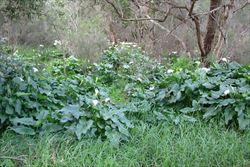
infestation (Photo: Sheldon Navie)

habit (Photo: Sheldon Navie)
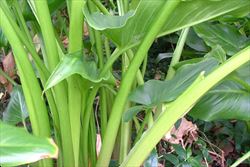
fleshy leaf stalks with sheathing bases (Photo: Sheldon Navie)
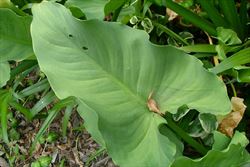
leathery leaf blade with wavy margins (Photo: Sheldon Navie)
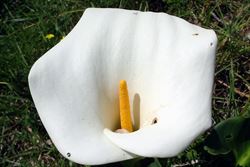
elongated flower spike, subtended by a large white petal-like bract known as a spathe (Photo: Sheldon Navie)
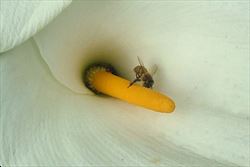
close-up of elongated flower spike, with numerous male flowers on top and several female flowers just visible at the base (Photo: Sheldon Navie)

close-up of immature fruit, which are enclosed inside the base of the old spathe (Photo: Sheldon Navie)

close-up of yellow mature fruit (Photo: Sheldon Navie)
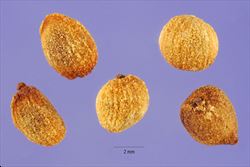
close-up of seeds (Photo: Steve Hurst at USDA PLANTS Database)

young plant (Photo: Sheldon Navie)
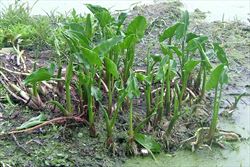
vigorous re-growth from tuberous creeping underground stems (Photo: Sheldon Navie)
Scientific Name
Zantedeschia aethiopica (L.) Spreng.
Synonyms
Calla aethiopica L.
Family
Araceae
Common Names
arum lily, calla lily, common arum lily, common calla, common calla lily, death lily, Egyptian lily, florist's calla, funeral flower, garden calla, Jack in the pulpit, lily of the Nile, lily-of-the-Nile, pig lily, St. Joseph's arum lily, trumpet lily, white arum lily
Origin
Native to southern Africa (i.e. Lesotho, South Africa and Swaziland).
Cultivation
Arum lily (Zantedeschia aethiopica) has been widely cultivated as a garden ornamental thorughout the wetter parts of southern and eastern Australia. Several modern cultivars are also available, the most popular of these probably being Zantedeschia aethiopica 'Green Goddess'.
Naturalised Distribution
Widely naturalised in southern Australia (i.e. in south-western Western Australia, in some parts of south-eastern and southern South Australia, in Tasmania and southern Victoria, and in the coastal districts of central and southern New South Wales. Also naturalised on Norfolk Island and Lord Howe Island, sparingly naturalised in south-eastern Queensland, and possibly naturalised in the coastal districts of northern New South Wales.
Naturalised overseas in the UK, the Mascarense (i.e. La Réunion), New Zealand, south-western USA (i.e. California and Oregon) and Hawaii.
Habitat
A weed of wetlands, swamps, waterways, gullies, irrigation ditches, neglected gardens, roadsides, open woodlands, waste areas, coastal environs and damp pastures in sub-tropical and warmer temperate regions.
Habit
A long-lived (i.e. perennial) clump-forming herbaceous plant with upright leaves and flowering stems usually growing about 1 m tall, but occasionally reaching up to 1.5 m in height. It produces creeping underground stems (i.e. rhizomes) and fleshy tubers.
Distinguishing Features
- a long-lived herbaceous plant with upright leaves and flowering stems usually growing about 1 m tall.
- its large leathery leaves (13-45 cm long and 8-25 cm wide) are borne on long, thick, stalks (40-150 cm long) and have wavy margins.
- its showy 'flowers' (up to 15 cm across) are produced at the top of long flowering stems.
- these 'flowers' consist of a white funnel-shaped and petal-like bract surrounding a bright yellow central flower spike.
- its yellowish berries (5-10 mm across) are oval in shape and contain several seeds.
Stems and Leaves
The leaves are all produced from the base of the plant, as are the smooth and fleshy (i.e. somewhat succulent) flowering stems. These flowering stems are up to 1.5 m tall, relatively thick and hairless (i.e. glabrous).
The leathery leaf blades are borne on long (40-150 cm long) and thick stalks (i.e. petioles) that are similar in appearance and texture to the flowering stems. These leaf blades are large (13-45 cm long and 8-25 cm wide) and either egg-shaped in outline (i.e. ovate), with a heart-shaped (i.e. cordate) base and pointed tip, or more or less arrow-shaped (i.e. hastate). They are dark green in colour, shiny in appearance, hairless (i.e. glabrous) and have entire but often wavy (i.e. undulating) margins.
Flowers and Fruit
The 'flowers' (i.e. inflorescences) are large and very showy (up to 15 cm across). They consist of a large enclosing petal-like bract (i.e. a spathe), that is pure white or ivory-white in colour, which surrounds a central flower spike (i.e. spadix) that is bright yellow or orange in colour. The 'spathe' (10-26 cm long) is greenish on the outside (particularly near the base) and somewhat funnel-shaped (i.e. tubular). It is split at the base and its tip is arched backwards (i.e. recurved). The central flower spike (i.e. spadix) is 5-10 cm long and bears many tiny single-sex (i.e. unisexual) flowers. Male flowers (yellow or orange in colour) are borne on the upper part of this structure and the female flowers (greenish in colour) are clustered at its base. Flowering takes place mainly during late winter, spring and early summer.
The fruit is a yellowish coloured berry (5-10 mm across) that is oval (i.e. ellipsoid) in shape (about 40-50 berries are produced on each inflorescence). Each of these fruit contains several rounded (i.e. sub-globular) seeds that are yellowish-brown in colour (about 3 mm across). These fruit are generally hidden within the remains of the spathe, and hence are not very conspicuous.
Reproduction and Dispersal
This species reproduces by seeds and also vegetatively via creeping underground stems (i.e. rhizomes) and tubers.
Seeds may be dispersed by water movement, birds and other animals. Local spread occurs via the creeping underground stems (i.e. rhizomes). These vegetative structures may also be dispersed larger distances by water movement, cultivation and in dumped garden waste.
Environmental Impact
Arum lily (Zantedeschia aethiopica) is regarded as a significant environmental weed in Victoria and Western Australia, and as an environmental weed in South Australia, New South Wales and Tasmania. It is actively managed by community groups in Western Australia and was recently listed as a priority environmental weed in three Natural Resource Management regions.
Other Impacts
This species is toxic to livestock and humans.
Legislation
This species is declared under legislation in the following states and territories:
- Western Australia: P1 - the movement of this species or its seeds is prohibited (in those parts of the state mentioned below), and P4 - the weed must be 'contained' (in the City of Albany, Augusta-Margaret River, Boyup Brook, Bridgetown-Greenbushes, the City of Bunbury, Busselton, Capel, Collie, Cranbrook, Dardanup, Denmark, Donnybrook-Balingup, Harvey, Manjimup, Mandurah, Murray, Nannup, Plantagenet, Serpentine-Jarrahdale and Waroona local authority areas).
Management
For information on the management of this species see the following resources:
- the Western Australian Department of Agriculture and Food information page on this species, which is available online at http://www.agric.wa.gov.au.
Similar Species
This species is quite distinctive, however it may occasionally be confused with Italian arum (Arum italicum) and the native cunjevoi (Alocasia brisbanensis). These species can be distinguished by the following differences:
- arum lily (Zantedeschia aethiopica) has green leaves and showy white inflorescences with a bright yellow flower spike in the centre. Its inconspicuous berries are yellowish-green to yellow in colour when ripe.
- Italian arum (Arum italicum) has slightly variegated leaves and greenish-white inflorescences with a yellowish flower spike in the centre. Its orange or bright red berries are usually conspicuously displayed in elongated clusters when ripe.
- cunjevoi (Alocasia brisbanensis) has green leaves and greenish coloured inflorescences with a greenish or yellowish coloured flower spike in the centre. Its bright red berries are usually conspicuously displayed in short, dense clusters when ripe.

